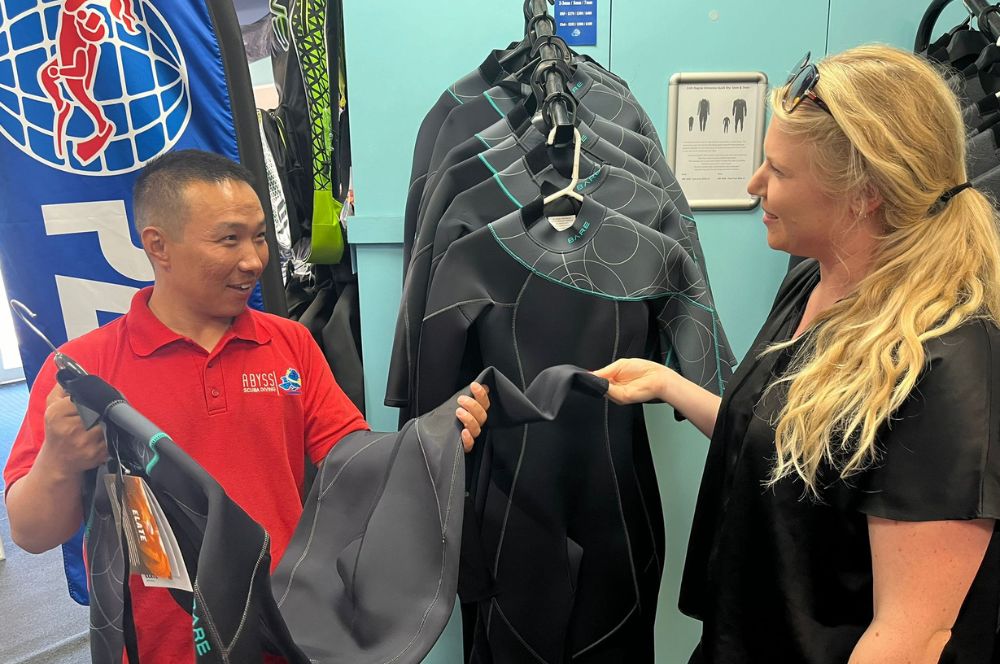You have 0 product(s) in your cart.
Abyss Scuba Diving
Scuba Diving Suits: Unveiling The Evolution Of Underwater Gear

The Evolution of the Modern Scuba Diving Suits
Navigating the depths requires the right scuba diving suits. Tailored to your diving environment and personal needs, the right suit is a game-changer. Our guide zeroes in on wetsuits and drysuits; their materials, features, and how to select the one that ensures your dive is both safe and enjoyable. Immerse yourself in the world of scuba diving suits and gear up for your next underwater adventure.
Key Takeaways
-
The development of the neoprene wetsuit in the 1950s, pioneered by Hugh Bradner, was a transformative event in the history of scuba diving suits, providing insulation, buoyancy, and protection to divers.
-
Modern scuba suits have evolved through technological advances to offer divers more comfort, improved thermal retention, and enhanced buoyancy control, with pioneering materials like OMNIRED Infrared Thermal technology being used to reflect a diver’s body heat.
-
Sustainability is becoming an integral consideration in the manufacturing of scuba suits, with the industry exploring eco-friendly materials and processes to reduce the environmental impact of underwater exploration.
A Dive Through History: The Evolution of the Scuba Suit

Long before the sleek wetsuits of today and even before World War II, the earliest forays into the underwater realm were driven by the pursuit of sustenance and treasure. Ancient divers plunged into the depths with little more than their bravery, venturing into an alien world that was as inhospitable as it was fascinating. These deep dives into the unknown marked the beginning of humanity’s exploration of the underwater world.
The evolution of diving gear has been a remarkable journey, marked by ingenuity and necessity. From the cumbersome suits that mirrored the appearance of space-age attire to the development of the diving bell in the 17th century, each advancement brought us closer to mastering the art of underwater exploration.
From Canvas to Neoprene: Material Advancements
The breakthrough came with the advent of neoprene, a game-changer in the history of scuba suits. This synthetic rubber’s insulating properties revolutionized thermal protection for divers, allowing them to retain precious body heat in frigid waters.
Initially, divers like Jacques-Yves Cousteau braved the depths without the comfort of modern wetsuits, relying on woolen garments for warmth. It wasn’t until the early 1950s that Hugh Bradner, a physicist, introduced the neoprene wetsuit, forever transforming the experience of divers by providing not just insulation but also buoyancy and protection.
Progress Towards the Modern Wetsuit
The subsequent decades witnessed a surge in material innovations, shaping the scuba diving suits into the form we recognize today. The latter part of the 20th century introduced materials like Gore-Tex and improved neoprene, which offered unmatched durability and comfort, making the suits lighter, more flexible, and more adept at conserving body heat.
Modern wetsuits now employ advanced features such as:
-
Advanced seam construction
-
Anatomically shaped designs
-
Greater range of motion
-
Snug fit that conforms to the body
Despite these advancements, divers must consider the delicate balance between comfort and the longevity of their suits, as the pursuit of higher performance often shortens the lifespan of the gear.
Diving into the Details: Understanding Scuba Diving Suits

In the intricate tapestry of scuba diving, suits are the threads that bind safety, comfort, and performance. As we delve into the nuances of scuba suits, we find a variety of designs tailored to meet the demands of divers and the environments they explore. Whether it’s the classic wetsuit that has become synonymous with scuba diving or the specialized drysuits designed for frigid waters, each piece of diving equipment/a> plays a crucial role in expanding the boundaries of underwater exploration.
The Essential Role of Wetsuits in Scuba Diving

The wetsuit is indispensable to the diver, providing warmth, flexibility, and a protective barrier against underwater perils. Its design is deceptively simple: a layer of water trapped between the suit and the skin, warmed by the diver’s own body heat, serves as the insulating blanket that allows for extended dive times. The thickness of the neoprene, typically ranging from 3 to 5 millimeters, is a crucial factor in tailoring the suit’s insulation to the diving conditions, while variations like the shorty wetsuit offer an alternative for warmer waters.
Drysuits for the Deep Diver
When the temperature plummets and the water turns icy, the drysuit becomes the diver’s best ally. Unlike wetsuits, drysuits are designed to keep the diver completely dry, with insulation provided by a layer of air rather than water. This not only ensures warmth but also presents a unique challenge in buoyancy control, necessitating specialized training for those who don the suit.
The materials and construction of drysuits, such as neoprene and waterproof shells, are tailored to withstand the rigors of cold-water ecosystems, enabling divers to witness wonders that are hidden from the warmer parts of our blue planet.
Specialty Suits for Specific Conditions
For the adventurer seeking to push the limits, specialty suits are the armor of choice. Designed to endure the rough embrace of a cave’s rocky walls or the eerie silence of a sunken wreck, these suits are fortified with abrasion-resistant fabrics and additional padding, ensuring the diver’s safety in the face of the unknown.
Added features, such as integrated weights and expandable bladders, offer divers precision in buoyancy control, a testament to the suit’s adaptability in specialized diving scenarios.
Innovations in Scuba Suit Technology

The realm of scuba diving is one of constant innovation, where technological advancements redefine the limits of what’s possible in the underwater world, including deep diving and the management of carbon dioxide levels.
Today’s scuba suits are marvels of engineering, employing cutting-edge materials and design principles that enhance the diver’s experience and safety.
Advanced Materials and Construction
At the forefront of these innovations is the integration of OMNIRED Infrared Thermal technology in neoprene wetsuits, a ground-breaking approach to thermal retention. By reflecting the diver’s body heat back, this technology ensures warmth even in the coldest depths.
The modern wetsuit is a layered system, combining various stitching techniques for durability and water resistance, while materials like titanium lining add to the suit’s structural integrity and thermal efficiency.

Enhanced Buoyancy Control in Modern Suits
Achieving neutral buoyancy is akin to the art of underwater ballet – a skill that modern scuba suits are designed to perfect. Innovations like the Avelo Scuba System’s hydrotank and the DSEND suit’s design have revolutionized buoyancy control, allowing divers to glide effortlessly through the water using compressed air.
The streamlined designs of these suits reduce drag, further facilitating a diver’s ability to navigate the underwater currents with precision and stay underwater for extended periods.
Eco-Friendly Diving Suits
With the health of our oceans at stake, the scuba industry is turning a new leaf towards sustainability. Eco-friendly diving suits mark a new chapter in gear manufacturing, where the environmental impact is as important as the performance of the suit itself. Manufacturers are exploring green materials and production methods, striving to ensure that our underwater adventures leave a positive legacy for the future.
Selecting the Perfect Scuba Suit

The quest for the perfect scuba suit is as personal as the dive itself, with factors such as water temperature and diving conditions playing pivotal roles in the decision-making process. Drysuits are the garment of choice for chillier waters, while scuba diving wetsuits cater to the warmer climes, each designed to optimize the diver’s comfort and safety.
Size and Fit: The Key to Comfort Underwater
The fit of a scuba suit is the cornerstone of comfort and thermal protection. A drysuit must be snug at the seals but roomy enough for insulation, while a wetsuit should cling to the body without restricting movement or breath. Divers are encouraged to try on different suits, mimic diving motions, and seek advice when needed to ensure the suit they select becomes a second skin that moves with them through the water.
The Importance of Thickness and Style
The thickness of a wetsuit is a balancing act between warmth and buoyancy, with variations available for different climates and personal comfort levels. From the full suit’s embrace in colder waters to the liberating cut of the shorty in tropical seas, the style of a wetsuit also dictates its performance and the diver’s freedom of movement.
Features to Look For in a Quality Dive Suit
When it comes to quality in a dive suit, the details make all the difference. The external layer, whether smoothskin or fabric, impacts the suit’s hydrodynamics and durability, while the type of zipper can affect ease of use and flexibility underwater.
Caring for Your Scuba Diving Suit
The longevity of a scuba suit, as well as other scuba equipment, is directly linked to the care it receives. This essential gear, when treated with respect and maintained properly, can be a reliable companion for many underwater adventures.
Cleaning and Maintenance Tips
Routine cleaning, which includes rinsing with fresh water and occasional soaks with cleaner, preserves the functionality and appearance of both wetsuits and drysuits. Drying and storage practices also contribute significantly to a suit’s lifespan, with careful handling ensuring it remains ready for the next plunge into the depths.
Repairing Your Scuba Suit
Regular inspections can uncover potential issues before they escalate, with prompt repairs maintaining the integrity of the scuba suit.
Longevity and Replacement
Factors such as the frequency of use and maintenance habits influence when a scuba suit should be retired in favor of a new one.
Summary
As we surface from our deep dive into the world of scuba diving suits, we are reminded of the remarkable journey from canvas suits to today’s advanced gear. The evolution of the scuba suit mirrors the human spirit’s relentless pursuit to explore, understand, and ultimately become one with the underwater world. With the right suit, the oceans’ mysteries are yours to unravel, and each dive becomes a new chapter in your personal anthology of aquatic adventures.
Frequently Asked Questions
What was the first significant advancement in scuba technology after the diving bell?
The first significant advancement in scuba technology after the diving bell was the development of the first open-circuit scuba system by Yves Le Prieur and Maurice Fernez in 1925. This invention allowed divers to breathe underwater without being tethered to the surface.
How does the insulation in a wetsuit work?
The insulation in a wetsuit works by trapping a layer of water between the suit and the diver's skin, which is then warmed by the body heat to create an insulating layer that helps maintain body temperature during dives.
What are the benefits of a drysuit over a wetsuit?
The benefits of a drysuit over a wetsuit include complete water exclusion, superior insulation in extremely cold waters, specialized buoyancy control training, and more thermal protection in frigid conditions, allowing for exploration of unique cold-water ecosystems.
How often should I clean my scuba suit, and what should I use?
Clean your scuba suit with fresh water after each dive and periodically soak it in a suit-specific cleaner to remove odor and dirt buildup, helping maintain the material and prolong its lifespan.
When should I consider replacing my scuba suit?
You should consider replacing your scuba suit when you notice material degradation, loss of elasticity, persistent leaks, or if it no longer provides adequate thermal protection or has suffered significant wear and tear. It's important for your safety and comfort while diving.
Recent Posts






